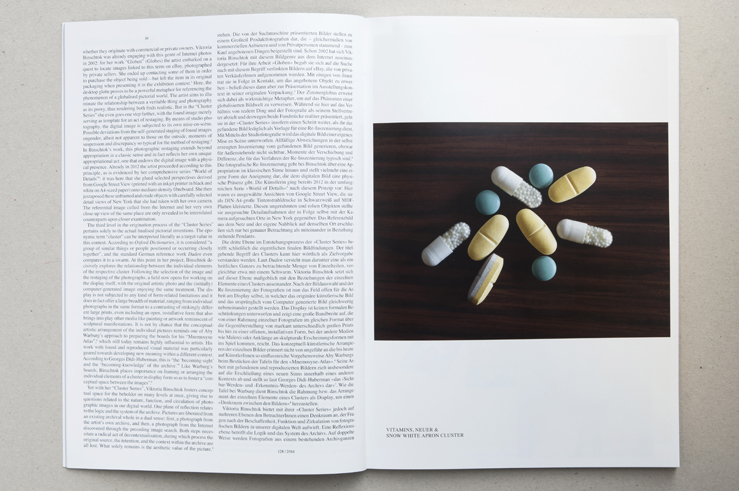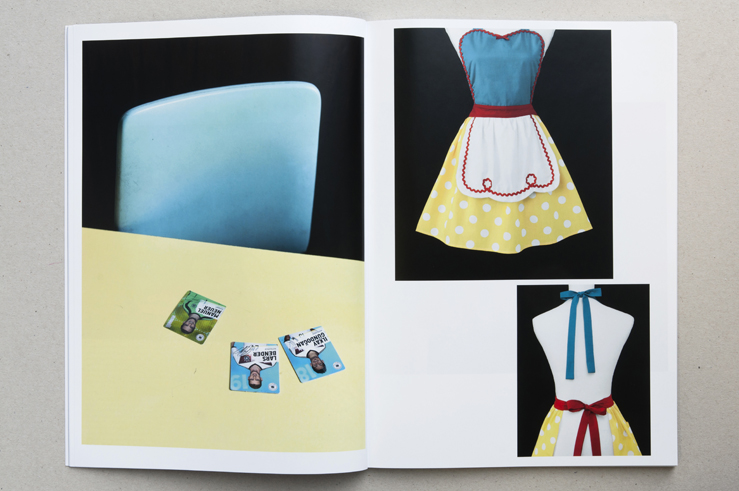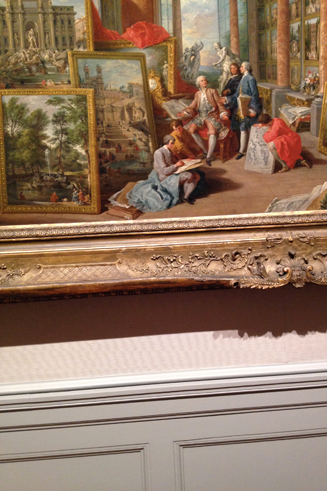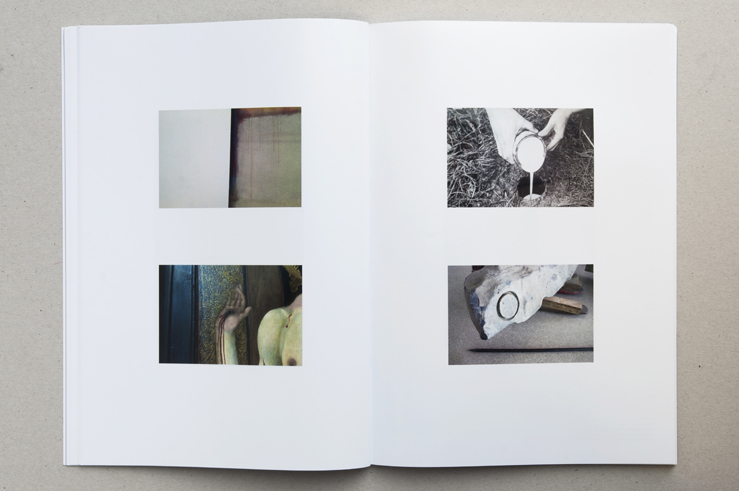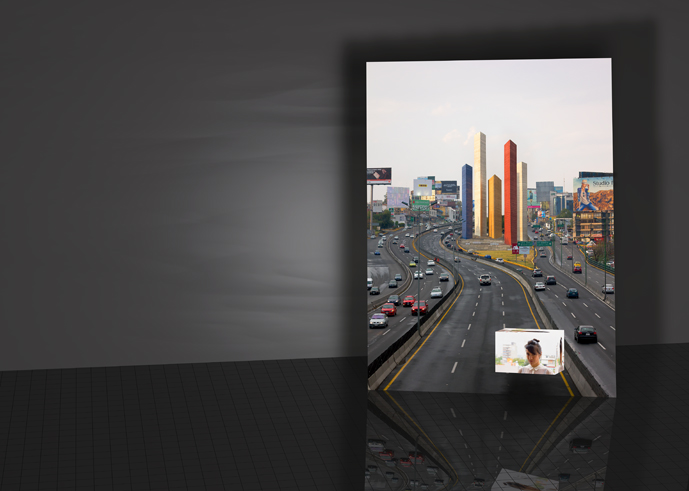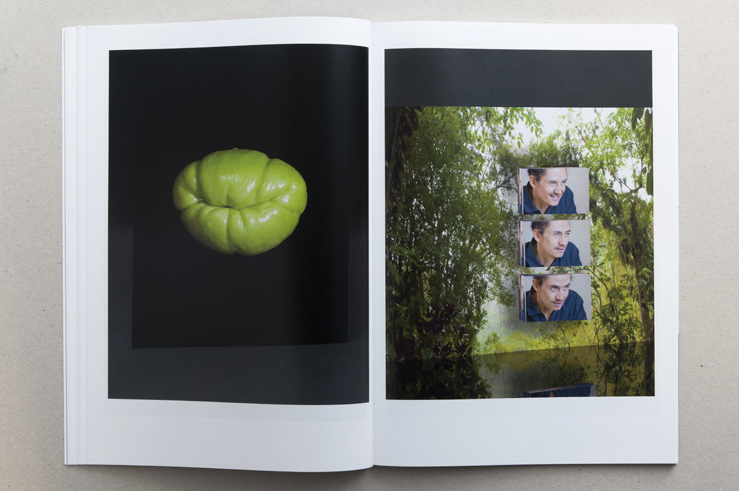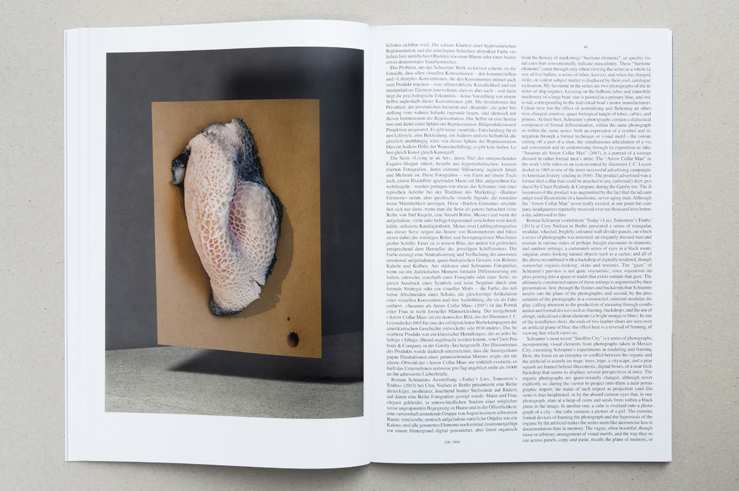Camera Austria International
128 | 2014
- CHRISTINA NATLACEN
Viktoria Binschtok: On Searching for and Finding Images - VIKTORIA BINSCHTOK
- DAVID BALZER
Luis Jacob: Looking at the Museum – “Show Your Wound” - LUIS JACOB
- PABLO LARIOS
Roman Schramm: The Detachable Collar - ROMAN SCHRAMM
- ALANNA LOCKWARD
Decolonising the (White) Gaze 4 / 4. Where Is (De)Coloniality?
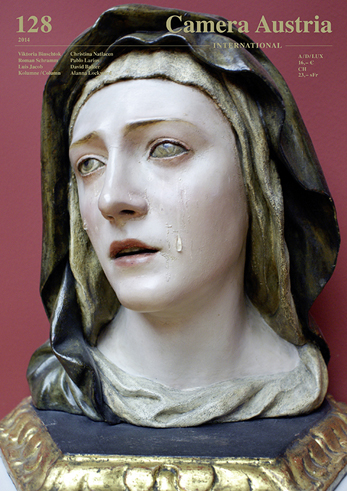
Preface
Playing through pictorial metaphors and aesthetic and semantic conventions, linking images in an associative-algorithmic manner based on structural characteristics, “poking” into apparent gaps, empty spaces and vulnerabilities in visual narratives—photographic strategies not connected by any clear or comprehensive context—are the main focus of interest in this issue of Camera Austria International.
What interests us in the works of the artists presented are the forms of researching and reordering specific to each of them, forms which, in these cases, do not process history or stories, events, historical archives etc., but instead other, already existing, everyday cultural or institutional forms for the on-going arranging of images. W. J. T. Mitchell termed such images that make reference to other images meta-pictures: pictures about pictures, in which a particular “pictorial self-reference” is inscribed. They produce theory through establishing representations, as Mitchell described in an interview with Georg Schöllhammer in 1998.
Read more →Camera Austria International 128 | 2014
Preface
Playing through pictorial metaphors and aesthetic and semantic conventions, linking images in an associative-algorithmic manner based on structural characteristics, “poking” into apparent gaps, empty spaces and vulnerabilities in visual narratives—photographic strategies not connected by any clear or comprehensive context—are the main focus of interest in this issue of Camera Austria International.
Viktoria Binschtok initially develops her series using search engines, which compile images according to criteria such as colour components and how they are distributed in the image, contour lines, and the structure of surfaces. In a subsequent process, these images serve as templates for a restaging through which displacements and differences ensue. In her essay, Christina Natlacen compares this conceptual arranging of individual images with “Aby Warburg’s approach to preparing the boards for his ‘Mnemosyne Atlas’, which still today remains highly influential to artists”. Warburg was also searching for a type of formal analogy—the “pathos formula”, which was supposed to provide him with a hinge for linking images across cultures and over centuries.
Luis Jacob’s work “Show Your Wound” (2010–12) consists of a sequence of twenty-six snapshots taken by the artist in museums and galleries across the globe. David Balzer characterises them as an “alliance of contemporary minimalism with historical religious painting and sculpture”. The taken images “are not ironic deconstructions or critiques of museums, as Dadaist readymades were, but rather intent inquires into them, and into the nature of looking”. The museum’s systems of order mainly address visitors solely as viewers: Do not touch. The art-historical works that roll past us disembody the image and visually render the bodies—a mechanism with inherently far-reaching consequences for current pictorial cultures.
Roman Schramm’s photographs, as Pablo Larios writes, progress “through loosely thematic series that operate as formal experiments with formal conceits …”. Around his photogenic objects, with the help of a 3D program, he creates one or also multiple spaces that extend beyond the edge of the picture and into the exhibition space. According to the author, these meanwhile absurd, comic constructions refer back to “visual and meaning conventions … the kind of cultural-industrial techniques that are wholly on display in our own era”. Schramm appropriates these conventions to simultaneously modify them and shift them onto themselves.
What interests us in the works of the artists presented are the forms of researching and reordering specific to each of them, forms which, in these cases, do not process history or stories, events, historical archives etc., but instead other, already existing, everyday cultural or institutional forms for the on-going arranging of images. W. J. T. Mitchell termed such images that make reference to other images meta-pictures: pictures about pictures, in which a particular “pictorial self-reference” is inscribed. They produce theory through establishing representations, as Mitchell described in an interview with Georg Schöllhammer in 1998.
This issue once again focuses above all on one idea, one that for us constitutes a fundamental guideline for understanding photographic practices: the fact that image production also represents a form of developing a theory about images. Our hope is to take you on a journey with this as well as other issues of our magazine and with our passion, that is not only one for seeing, but also for thinking.
Reinhard Braun
and the Camera Austria Team
December 2014
Cover: Luis Jacob, from the work: Show Your Wound, 2010–12. Series of 26 c-prints, 9 × 6 each.
Entries
Forum
Presented by the editors
Camilla de Maffei
Elena Geroska
John MacLean
Marion Pedenon
Yoav Friedländer
Birgit Krause
Exhibitions
Ricarda Roggan: Echo
Kunstverein Hannover
Wilhelm-Hack-Museum, Ludwigshafen
JENS ASTHOFF
Raphael Hefti
Nottingham Contemporary
EMMA COCKER
Manifeste! Eine andere Geschichte der Fotografie
Fotomuseum Winterthur
(Mis)Understanding Photography. Werke und Manifeste
Museum Folkwang Essen
ESTELLE BLASCHKE
The Library Vaccine
Artists Space, New York
ANNE KÖNIG
Pictures, Before and After – An Exhibition for Douglas Crimp
Galeria Buchholz, Berlin
Before and After Pictures: A Symposium for Douglas Crimp
Kino Arsenal, Berlin
STEFANIE SEIBOLD
Walead Beshty: A Partial Disassembling on an Invention Without a Future: Helter-Skelter and Random Notes in Which the Pulleys and Cogwheels Are Lying Around at Random All Over the Workbench
The Curve, Barbican Center, London
ELLIE ARMON AZOULAY
Joel Meyerowitz: Retrospektive
NRW-Forum Düsseldorf
ANDREAS PRINZING
Dayanita Singh: Go Away Closer
Hayward Gallery, London
Museum für Moderne Kunst, Frankfurt/Main
Multimedia Art Museum, Moskau
KERSTIN STREMMEL
Gefangene Bilder. Wissenschaft und Propaganda im Ersten Weltkrieg
Historisches Museum, Frankfurt/Main
GISLIND NABAKOWSKI
Kunst/Geschichten
Museum der Moderne Salzburg
ULRIKE MATZER
Eyes On – Monat der Fotografie Wien
Memory Lab. Photography Challenges History
MUSA, Wien
2D23D – photography as sculpture / sculpture as photography
OstLicht, Wien
Aftermath. Changing Cultural Landscape: Tendenzen zeitgenössischer post-jugoslawischer Fotografie
Galerie Photon, Wien
Fotogalerie Wien
NINA SCHEDLMAYER
Richard Hamilton
Tate Modern, London
Museo National Centro de Arte Reina Sofía, Madrid
HANS-JÜRGEN HAFFNER
Storyteller: The Photographs of Duane Michals
Carnegie Museum of Art, Pittsburgh
Peabody Essex Museum, Salem
ROBERT RACZKA
steirischer herbst. I prefer not to … share!
Various venues, Graz and environs
MARTIN HERBERT
Horst: Photographer of Style
Victoria and Albert Museum, London
MATTHEW SHAUL
Garry Winogrand
San Francisco Museum of Modern Art
National Gallery of Art, Washington
Jeu de Paume, Paris
EIKO GRIMBERG
La Photographie Performe (The Body and the Archive)
Centre Photographique d’Ile-de-France, Pontault-Combault
MICHÈLE COHEN-HADRIA
Annette Kelm: Staub
Kölnischer Kunstverein, Köln
HOLGER OTTEN
Schwindel der Wirklichkeit
Akademie der Künste, Berlin
SØNKE GAU
Books
Das Auge des Arbeiters. Arbeiterfotografie und Kunst um 1930
Hrsg. von Wolfgang Hesse.
Spector Books, Leipzig 2014
RENATE WÖHRER
Bernd Stiegler: Spuren, Elfen und andere Erscheinungen. Conan Doyle und die Photographie
S. Fischer, Frankfurt/Main 2014
TACO HIDDE BAKKER
Ulrich Ziemons: Aufzeichnungen eines Storm Squatters. George Kuchars »Weather Diaries«
transcript, Bielefeld 2014
The George Kuchar Reader
Hrsg. von Andrew Lampert
Primary Information, New York 2014
NAOKO KALTSCHMIDT
THE REVOLVING BOOKSHELF
Das Stottern der Bilder. Über einige Doppelseiten in Fotobüchern von Einar Schleef und Michael Schmidt
Einar Schleef: Zuhause
Suhrkamp Verlag, Frankfurt/Main 1981
Michael Schmidt: Lebensmittel
Snoeck, Köln 2012
JAN WENZEL
Imprint
Publisher: Reinhard Braun
Owner: Verein CAMERA AUSTRIA. Labor für Fotografie und Theorie.
Lendkai 1, 8020 Graz, Österreich
Editors: Margit Neuhold, Christina Töpfer, Rebecca Wilton
Franziska Schurig (Intern)
Translators: Dawn Michelle d’Atri, Amy Klement, Peter McCavana, Katrin Mundt, Wilfried Prantner.
English proofreading: Dawn Michelle d’Atri
Acknowledgement: David Balzer, Viktoria Binschtok, Michèle Cohen-Hadria, Chris Curreri, Martina Egli, Yoav Friedländer, Jonathan Gaugler, Corinn Gerber, Elena Geroska, Ralph Goertz, Luis Jacob, Viviana Kleinert, Birgit Krause, Pablo Larios, Hélène Loupias, Camilla de Maffei, John MacLean, Christina Natlacen, Marion Pedenon, Ember Rilleau, Walid Sadek, Barbara Schiltenwolf, Roman Schramm, Therese Seeholzer, Joan Semmel.
Copyright © 2014
All rights reserved. No parts of this magazine may be reproduced without publisher’s permission.
Camera Austria International does not assume any responsibility for submitted texts and original materials.
ISBN 978-3-902911-13-1
ISSN 1015 1915
GTIN 4 19 23106 1600 5 00128


